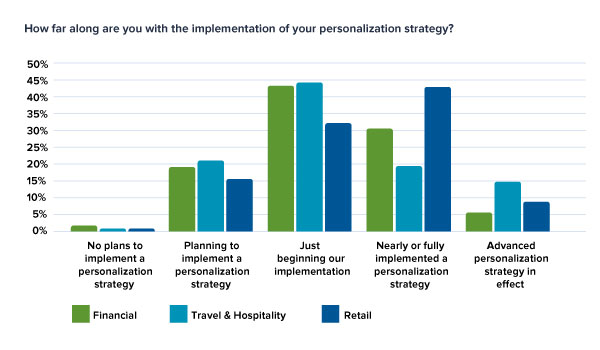Personalized marketing draws more bank spending
4 in 10 just beginning implementation. Data quality is biggest challenge
- |
- Written by Bill Streeter
 Goodbye generalities! More and more financial services firms personalize communications with customers and prospects.
Goodbye generalities! More and more financial services firms personalize communications with customers and prospects.
We’ve come a long way from “Dear Occupant.”
Now with the internet and social media providing troves of “big data” and analytical engines sorting through it for patterns and triggers, marketers are personalizing pitches, offers, and messages as never before.
One example is targeted web ads that are based on a person’s previous search behavior. You know, the ones that seem to follow you no matter where you go on the internet.
While the retail industry is at the forefront of personalization practices, the financial services business has also grown serious about it, over the past year, according to a recent study. The research was conducted by WBR Insights on behalf of personalization software provider Monetate.
Lifetime value, loyalty key goals
The Second Annual Personalization Development Study posed questions to 513 marketing decision makers in three industries—Retail, Financial Services, and Travel and Hospitality—in the U.S. and U.K. It defined true 1-to-1 personalization as “the ability to interact with each individual, at any moment, across all touch points, based on everything known about them.”
The research found that personalization efforts have advanced overall and are now considered a long-term strategy by all three industries. Respondents were asked, for example, what their primary business goal is for implementing personalization. Roughly a third in all three industries answered, “Increase customer lifetime value.” This goal, however, was second to “Increase customer loyalty,” which, among financial institution marketers, was the number one driver with just over 40% selecting that.
About 70% of respondents in financial services indicate they are getting a positive return on their investment from personalization, according to the survey.
Financial institutions ramp up
As the accompanying chart shows, roughly 60% of financial services respondents are just beginning to implement or planning to implement a personalization strategy. Still, just over 30% have a nearly or fully implemented strategy, and another 5% have an advanced strategy in place. As can be seen, retailers are further ahead, with about 50% in those two categories.

Retailers still hold the edge in implementing personalization, but financial services industry is not far behind.
For the respondents who say they have a dedicated personalization budget, the largest segment overall (40%) reported that the percentage of their marketing budget dedicated to personalization is in the 10-20% range, followed by about 33% that dedicate 21%-30% to personalization.
All three industry groups expect to increase personalization budgets this year—and nearly 70% of financial services respondents indicate this.
The survey looked at budgets from several other perspectives, including companies that had met revenue expectations versus those that missed them, and companies that use financial incentives to help achieve personalization goals.
Top challenges to personalization
The study asked marketers to rank-order a list of nine obstacles to achieving true 1-to-1 personalization. These included data integration, automating to scale, and assembling a real-time view of the customer.
The survey report notes that the number one constraint in 2017 was data quality at about 45% of all respondents. “This is a dramatic shift from last year where data quality ranked 6th,” the report states. “Last year, organizational constraints ranked number one as most companies were just starting their personalization journey… We believe the shift is a reflection of companies adopting more mature personalization efforts, based upon more data sources, and realizing the importance of the quality of the data.”
The second-highest-ranked obstacle overall was “Understanding buyer behavior in context,” followed closely by “Building a sustainable data architecture.” This pattern varied slightly when looked at by industry. For financial services marketers, data architecture ranks as the number two obstacle by a slight margin.
Machine learning plans probed
A new question in the second personalization survey asked respondents if they already have invested in or plan to invest in machine learning technology for personalization efforts.
Overall the report notes a planned spike in spending for this technology over the next 12 months. About one quarter of financial institution respondents say they “Already invest in machine learning,” just behind retailers, the leader of the three industries. Just over 70% of financial services marketers, however, say they will invest in the next 12 months (roughly 33% of them in the next six months).
Other questions explored which data sources and channels are used to personalize customer experiences.
Download the report [Registration required]
Tagged under Management, Duties, Retail Banking, Customers, Feature, Feature3,













